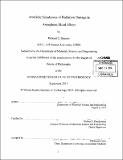Atomistic simulations of radiation damage in amorphous metal alloys
Author(s)
Baumer, Richard E. (Richard Edward)
DownloadFull printable version (17.72Mb)
Other Contributors
Massachusetts Institute of Technology. Department of Materials Science and Engineering.
Advisor
Michael J. Demkowicz.
Terms of use
Metadata
Show full item recordAbstract
While numerous fundamental studies have characterized the atomic-level radiation response mechanisms in irradiated crystalline alloys, comparatively little is known regarding the mechanisms of radiation damage in amorphous alloys. Knowledge of collision cascade dynamics is lacking, both with respect to the possibility of sub-cascade formation and concerning the types of damage created in individual cascades. This Thesis resolves these knowledge gaps through a systematic simulation study of the radiation response of amorphous metal alloys. Using a molecular dynamics simulation of /2 MeV ion irradiation in a realistic 2 billion-atom molecular dynamics simulation in amorphous Cu₅₀Nb₅₀, I show that radiation creates isolated nanometer-scale zones with rapidly quenching liquids. Quenched liquids reach large pressures and emit stress pulses that trigger polarized plastic deformation in adjacent material. In order to identify liquid zones in irradiated amorphous Cu₅₀Nb₅₀, I use molecular dynamics simulations to characterize the properties and glass transition temperature of uniform liquid Cu-Nb alloys. I show that radiation-induced liquid zones rapidly quench to material with the same properties as a uniform liquid quenched at an equivalent quench rate approaching 1014 K/s. These "super-quenched zones" (SQZs) are approximately 10 nm in diameter and provide a mechanistic explanation for radiation-induced swelling and ductilization in metallic glasses. The identification of plasticity adjacent to SQZs is an unexpected damage mechanism that could prove a limiting factor for the application of amorphous alloys in radiation environments. To aid selection of amorphous alloys with resistance to collision-induced plasticity, I formulate a micro-mechanical model for collision-induced plasticity in irradiated metallic glasses. The analytical model successfully ranks the damage-resistance of irradiated Cu- Nb alloys and should enable selection of amorphous alloys with optimized radiation tolerance. Finally, through characterization of quenched Cu₅₀Nb₅₀, I reveal that glass transition in Cu₅₀Nb₅₀ occurs by gelation due to formation of a mechanically stiff, percolating network of atoms with icosahedral local packing at the interfaces between compositionally enriched regions. These features of glass transition are similar to gelation processes in polymeric and colloidal gels and suggest new approaches for understanding glass transition in bulk metallic glasses.
Description
Thesis: Ph. D., Massachusetts Institute of Technology, Department of Materials Science and Engineering, 2013. Cataloged from PDF version of thesis. Includes bibliographical references (pages 121-131).
Date issued
2013Department
Massachusetts Institute of Technology. Department of Materials Science and EngineeringPublisher
Massachusetts Institute of Technology
Keywords
Materials Science and Engineering.